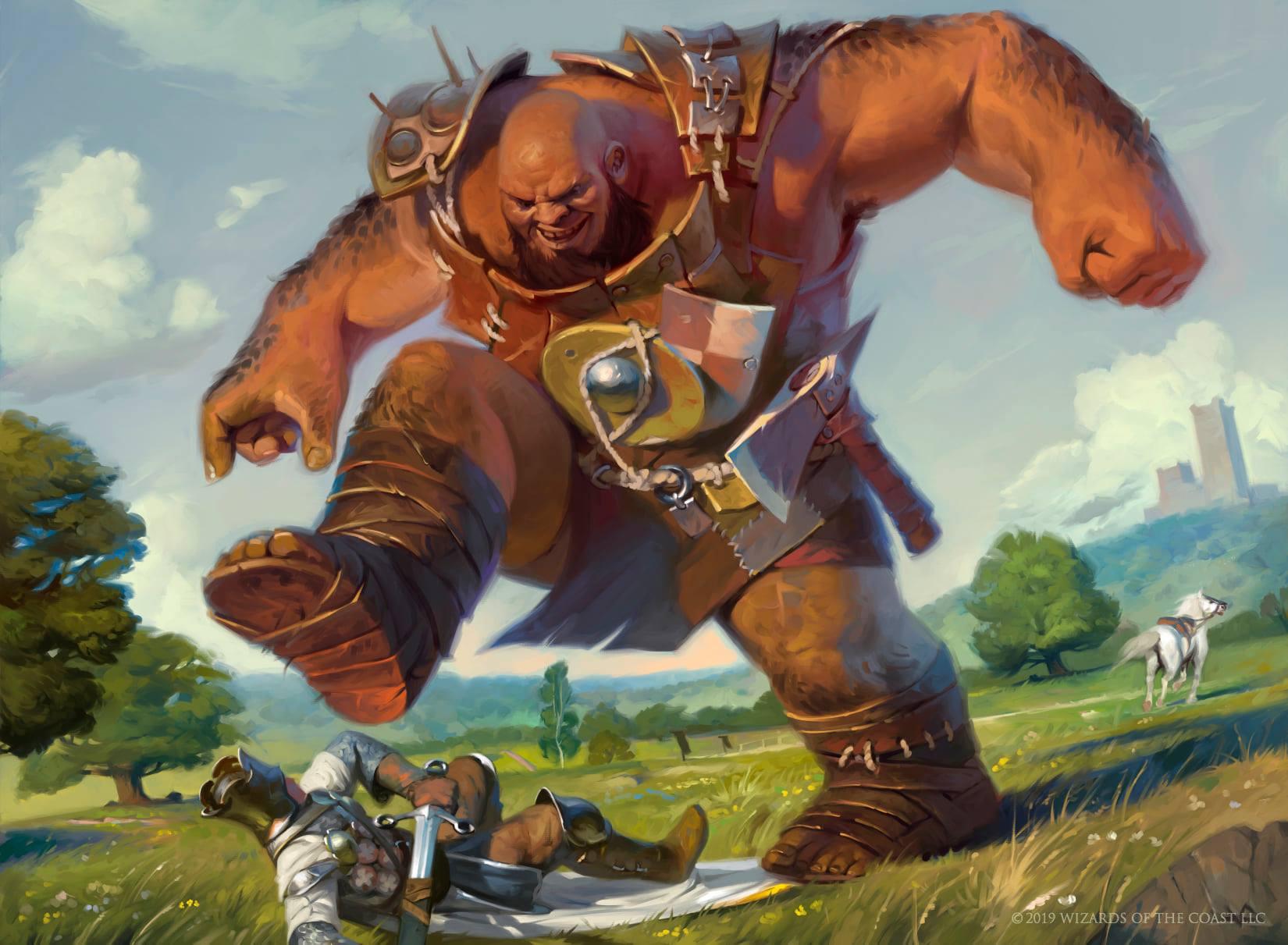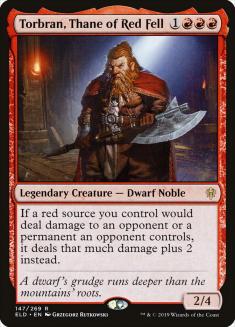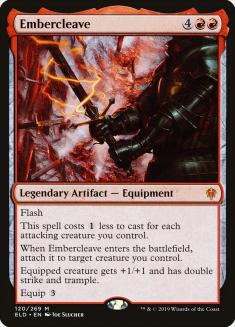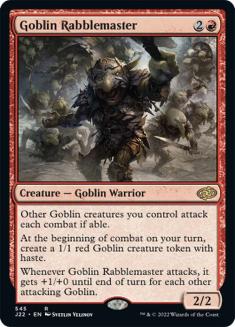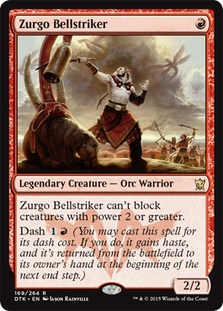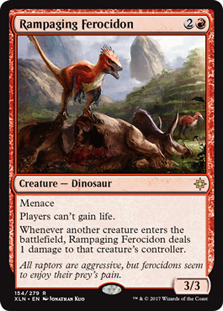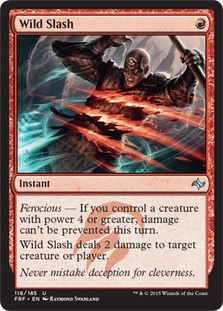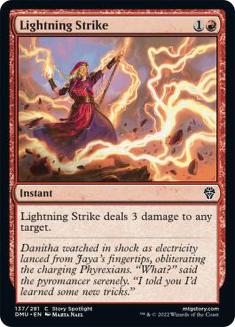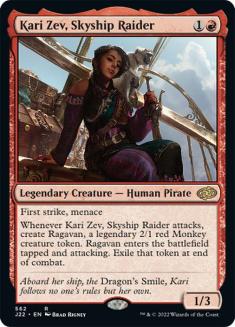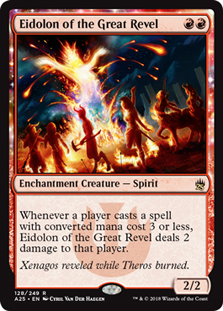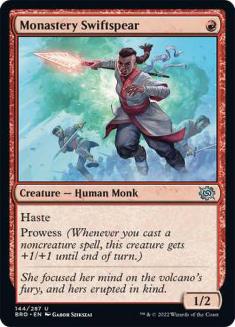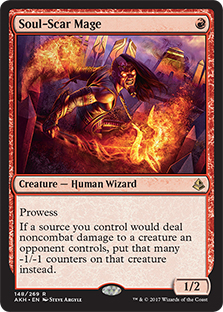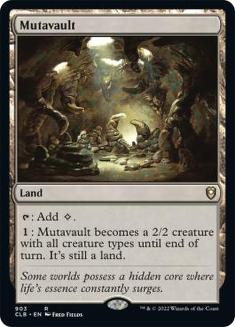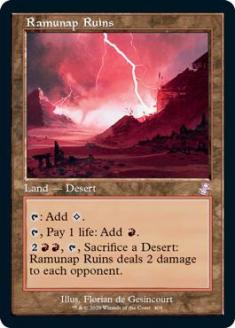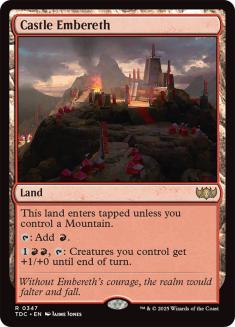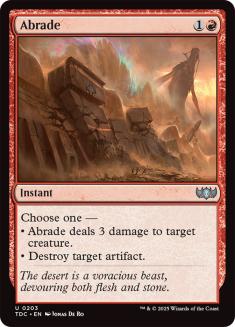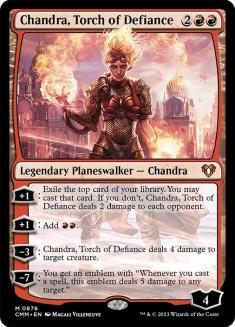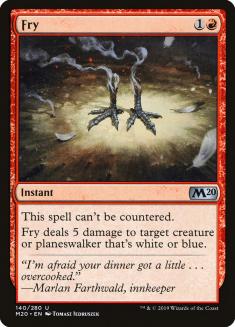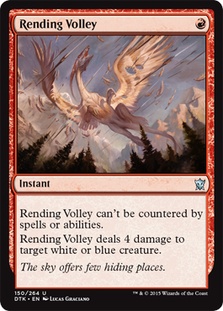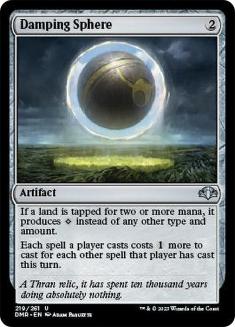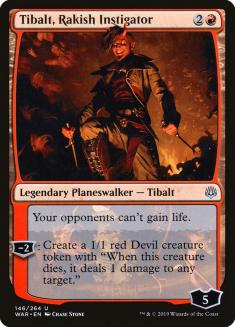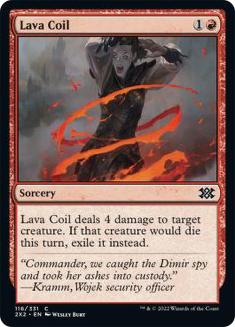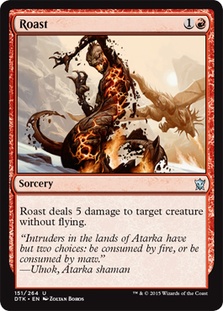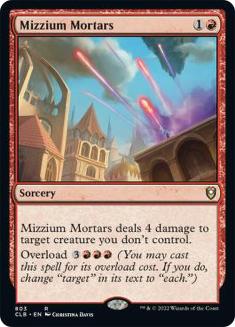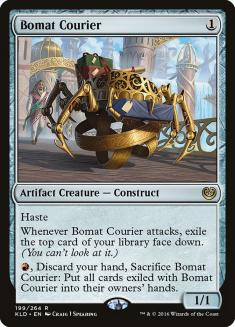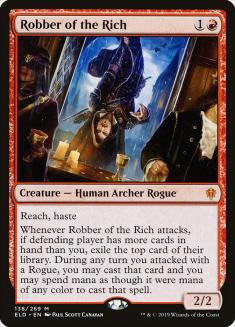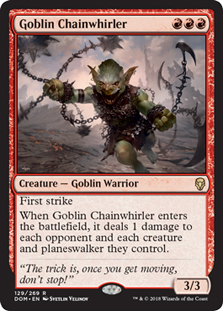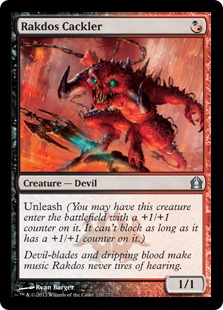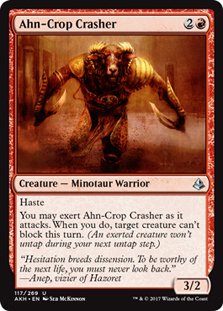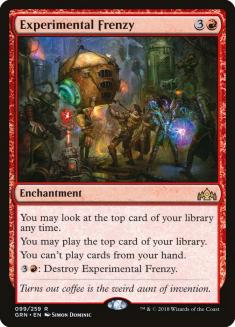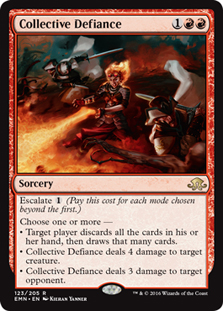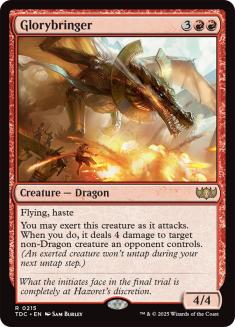With a push toward online tournaments, Pioneer has been thrust into the spotlight. While Magic Arena’s main emphasis is on Theros Beyond Death Standard, Magic Online has decided to run quite a few open-entry PTQs featuring the Pioneer format. With that, I figured it was time to update one of my favorite decks in the format: Mono-Red Aggro!
Throughout Pioneer’s short history, there have been a number of interesting builds of Mono-Red, ranging from low-to-the-ground to Chonky with Glorybringer. Some great minds like Aaron Barich and Patrick Sullivan have done work on the archetype, but I’ve been living in the mountains, in this format, for months! As a result, I’ve decided to make a new Red Box, a deckbuilding toolkit used to build different versions of Mono-Red for upcoming tournaments.
Much like the Temur Box from Modern, the Red Box will feature the core of the deck, as well as a number of interesting items that can slot in at any given point. Revisiting this Red Box from time to time might help me re-evaluate the Pioneer metagame, as well as Mono-Red’s place inside of it. The flexibility in the archetype is exceptional, giving you the ability to go low or high depending on what you need to attack at any given time.
A few weeks ago, Dimir Inverter was all the rage. My reaction was to punish them by going low with Eidolon of the Great Revel. My record with various builds of Mono-Red against Dimir Inverter was somewhere around 13-3, but the trick was finding a build that could perform this well while still being solid against the rest of the field. Uro and Sultai Midrange were pretty tough, but hedging with maindeck Rampaging Ferocidon made the matchup palatable.
But what about now?
The biggest deck in Pioneer at the moment is a Mono-White Devotion deck featuring the combo of Heliod, Sun-Crowned and Walking Ballista. The deck can be a little rough for Mono-Red at times, but I think we can tweak our build to fight it. Maindeck Rampaging Ferocidon is a great way to stall the combo itself, but how can we contain them if they’re able to kill the Ferocidon itself? After sideboard specifically, they have access to a lot of cheap enchantment removal that could be problematic for us.
Here’s how I would build Mono-Red Aggro for the current Pioneer metagame:
Creatures (27)
- 4 Eidolon of the Great Revel
- 4 Goblin Rabblemaster
- 4 Monastery Swiftspear
- 1 Zurgo Bellstriker
- 2 Kari Zev, Skyship Raider
- 4 Soul-Scar Mage
- 2 Rampaging Ferocidon
- 4 Bonecrusher Giant
- 2 Torbran, Thane of Red Fell
Lands (23)
Spells (10)

I feel like we’re in a world where Torbran, Thane of Red Fell is more necessary than good. I love Chandra, Torch of Defiance but we need some explosive damage dealers that steal games. In an ideal world, we could play both without feeling guilty because we’d have the time to go a little bit bigger. But in the current metagame, we have to go low and fast to close the games before our opponents go much bigger than us or combo kill us. That’s just the facts of life at the moment.
Torbran and Embercleave both want token generators, so it only makes sense that you’d be playing both in one specific build. At the current iteration of Pioneer, I think Embercleave is quite strong. People are tapping out constantly so having a couple of ways to punch through big damage is awesome. People are finally starting to move away from Dimir Inverter as well, which means our hand is relatively safe from Thoughtseize. So when we do draw Embercleave, there’s a reasonable chance it resolves and dunks on our opponent like Michael Jordan in the nineties.
Embercleave is not difficult to disrupt, but people are more focused on doing their own thing right now, which means you get to chop ’em up. For a long time now, I’ve been under the impression that those who get to use most of their mana in a game are favored to win. Mutavault was key in Chonky Red’s success because it gave you enough ways to use that extra mana and turn it into damage or battlefield advantage via attacking planeswalkers. That sentiment, while less true than before, still holds some water. As a result, people tend to tap out on their own turn quite a bit. While you don’t have Inverter of Truth into Thassa’s Oracle to win the game on the spot, Embercleave is a fine replacement in many scenarios.
A golden oldie cut long ago, this bad boy is back with a vengeance. It’s no secret that Goblin Rabblemaster pairs well with Embercleave, so if you see one you’re likely going to see the other. And the little syngery pickups that you get from playing Goblin Rabblemaster like extra damage from Torbran or enabling Embercleave is just icing. Goblin Rabblemaster has always been good, but there are spots where other three-drops are better. If Torbran and/or Embercleave ever get the axe again, it’s likely Rabblemaster gets cut as well.
I’ve had quite a few people ask me about this one, but long story short I just wanted another one-drop creature and I feel like Zurgo Bellstriker is currently the best singleton. There aren’t a lot of creatures with two power for one mana in the color red, and many of them have severe drawbacks. Zurgo can’t block big things but he can certainly dash in to deal lethal damage in a pinch. I’ve found him to be exactly “okay,” but I haven’t found something better, and I definitely miss having that extra early drop when I don’t include him or some other one-drop in my list.
This one should likely be raised to a four-of, but we have to keep our curve under consideration at all times. Playing too many three-mana creatures will result in stalling out early and getting dumpstered before we can get off the ground. Having a good curve is the way Mono-Red decks thrive in a hostile metagame. If you miss one or two of your early drops, you’re relying too much on your spot removal or three- and four-drops to do most of the heavily lifting, but those get outclassed in a hurry against midrange or control opponents.
Rampaging Ferocidon is an obvious pick if you don’t want to Embercleave, and it’s still being included here. The only reason we aren’t playing the full four copies in the maindeck is because we just can’t really afford to while fitting in all the things we want to fit in.
The one-two punch. We’re playing the most efficient burn at our disposal. Wild Slash and Lightning Strike act as both cheap removal as well as burst damage to finish our opponents. Alongside Torbran, these two get a lot better, acting as a way to steal games that you have no business winning. I often get asked if the ferocious on Wild Slash is necessary, and if someone could choose to play Shock instead, and my response has always been the same: I’ve only ever used the ferocious on Wild Slash once or twice. It does come up from time to time, mostly for things like Gideon of the Trials right now, but honestly it’s almost irrelevant.
This one is a heater and likely the big reason this deck exists and is good at all. Bonecrusher Giant is your two- and three-drop every single game, making your range of keeps for curve considerations higher. It gives you flood protection by helping you use all your mana every turn, and even punishes your opponent when they try to kill it. It’s hard to overstate just how good Bonecrusher Giant is in this deck.
This one functions poorly with Rampaging Ferocidon, but the extra damage you deal yourself isn’t that meaningful in most matchups. I consider that similar to the tax of playing Eidolon of the Great Revel. Just make the damage matter more when the opponent takes some!
Kari Zev is one of the better two-drops in the format as far as damage potential is concerned, but it fails the test of gaining card advantage in the face of removal. It does dodge Wild Slash and Stomp, making it huge for matchups like the mirror. It also generates two bodies for both Embercleave and Torbran!
Speaking of Eidolon of the Great Revel, we’re still playing four because I have yet to hate it. Even in the first game of matchups where I know it’s weak, it’s never that bad. It can’t help you win games that you’re losing, but it can certainly help wrap up games that are close. If you’re on the play, it’s phenomenal in almost every spot. When combined with Torbran, it becomes outrageous.
I think there’s a good chance that combo like Lotus Breach comes back in a big way, and it would benefit us to be prepared by playing cards that are good against them while still being solid against the field. I credit Eidolon of the Great Revel with much of my success in the red archetype as of late. It was wild to me how mediocre Eidolon of the Great Revel was in early iterations of Mono-Red Aggro in Pioneer, but I think the problem was how we were building the deck all along.
These two are oldies but goodies. Chonky Red had me really feeling Soul-Scar Mage, even though it didn’t have haste. Slightly large creatures need to be taken down a peg! The added benefit of making combat nearly impossible for your opponent is also a big plus. Shrinking creatures via burn is so sick!
This is the one card I always wanted to play more of. It was a huge reward for playing extra lands in Chonky Red (26!), but it still plays well in a more aggressive build. The restrictive cost of Eidolon of the Great Revel makes it hard to play more, but I could easily see fitting in four of these if we move away from the RR and RRR spells.
These two lands, alongside Mutavault, help fight flooding. Aggro decks tend to falter when they draw too many lands, and having access to these lands makes life much better. In the long term, you’ll see just how many games are won and lost by just having these in your deck. And the only downside to playing them is the occasional (and rare) land entering the battlefield tapped or dealing you a few points of damage while you cast your spells.
The Sideboard
This removal spell comes in clutch against a number of opponents, but it shines as a generic removal spell that can come in whenever you want to go a little slower. It’s been great against the resurgence of Izzet Ensoul, but it’s also just nice to have some way to kill random artifacts. I’ll just say that having a way to kill The Great Henge has come in clutch multiple times!
In a perfect world, you could play four copies of this in your maindeck and it would be excellent. There’s a chance that doing so is just correct anyway! However, I think Torbran and Embercleave are slightly better, but that can change in a second. One of the best parts of having a Red Box is that, when something loses its luster, you can always find a replacement. Chandra and Torbran occasionally go well together, but more often than not they’re at odds. Chandra is excellent at playing longer games, while Torbran excels at closing speed.
Fry and Rending Volley occupy a lot of the same space, but I’ve found that they’re useful in different matchups. Fry shines in all the same matchups as Rending Volley, except it also has the ability to kill planeswalkers. Fry is also good in matchups like Dimir Inverter in small doses, giving you ways to insta-kill your opponent by sniping their Jace, Wielder of Mysteries. But the one-mana cost of Rending Volley against Bant Spirits is unreal.
As I mentioned earlier, I think there’s a chance that Lotus Breach comes back to haunt us, so we need to be prepared. It’s only good in that matchup, but it is one hell of a card there because it shuts down both the storm element as well as the extra mana generation from Lotus Field proper.
These two fill the same role, and I just found that I want more cards that have that type of effect. Tibalt is weaker than Ferocidon in general, but it’s harder for some opponents to kill and we can only play four copies of Ferocidon!
When Mono-White Devotion runs wild, as its doing right now, having permanents that keep your opponent from combo killing you allows you to play regular Magic against them. As we all know, Mono-White Devotion doesn’t exactly play regular Magic all that well. They have some mopey cards that all kinda work alongside Heliod, but are rather weak without it. These two anti-lifegain cards are strong here, but are fine against a number of other archetypes. Decks that gain a lot of life over the course of the round are usually solid against Mono-Red Aggro. If one of their permanents can gain more life than something like Lightning Strike can deal damage, you can see the value in having access to these cards!
This is where things start to get tricky, because I honestly never know which of these is “the best.” From time to time, I like to give Mizzium Mortars another shot. It functions well alongside Chandra, Torch of Defiance thanks to the extra mana generation, but it also doesn’t exile the creature and can’t kill stuff that has five toughness.
Roast can’t touch flyers like Bant Spirits but is one of the few spells we have access to that can trump Lovestruck Beast, a card we have a lot of trouble beating sometimes. I hate Roast, but it’s sometimes a necessary evil. Right now, there aren’t a lot of Lovestruck Beasts running around, so I’m fine leaving it on the bench.
Lava Coil is getting the nod right now, though I think Mizzium Mortars is a potentially better choice. As I’ve said, this type of decision is usually made at the last minute based on trends I’ve seen in popular decks or trends I’ve seen in deckbuilding.
On the Sidelines
There are quite a few cards currently sitting on the sidelines that need a second look. These cards should be in your Red Box at all times, because there’s a good chance you’ll need them in the near future!
Aaron Barich loves this one, as do I, because it signifies a return to an ultra-aggressive front. Bomat Courier rewards you for emptying your hand. Killing your opponent’s creatures while filling up your Bomat Courier ensures you get to pop it for value on the fourth or fifth turn. Bomat Courier doesn’t hit that hard, but the threat of extra cards helps you in longer games while also rewarding you for loading your deck up with cheap spells.
Like Bomat Courier, this one hits hard and fast while accruing some amount of card advantage. I think of these two cards like two sides of the same coin. While playing Bomat Courier might be more often correct than Robber of the Rich, haste creatures are great at pressuring planeswalkers and piling up damage. The fact that they both can gain card advantage is a huge bonus.
While this one is at odds with Mutavault specifically, I find there to be quite a few spots where Goblin Chainwhirler is a desirable card for various forms of Mono-Red. It’s quite powerful in a number of matchups, but it just fails miserably at interacting with combo decks on the damage front. At least Rampaging Ferocidon is hard to block and deals some extra damage when they do play blockers or Inverter of Truth!
If the format goes back to Llanowar Elves all the time, Chainwhirler is a slam dunk. But right now, that’s just not the place we’re at.
I’ve seen this one start popping up from time to time. It’s almost as good as Zurgo Bellstriker, but it’s much better in multiples because it isn’t legendary. So if you’re really in the mood for a 2/2 for R, you could do worse than Rakdos Cackler.
This one pairs nicely with Bomat Courier if you want to go that route. I think there’s like a Bomat Courier and Robber of the Rich build that utilizes Ahn-Crop Crasher nicely. It was excellent when it was in Hour of Devastation Standard, and I can only imagine it’s still decent in the right spots.
This is one I want to re-emphasize because it was a huge part of our deck, and now it’s a singleton sideboard card. It’s currently fighting for the same slot as Torbran and we are unable to fit so many expensive cards in our deck as to let us play both. Don’t get me wrong, I think Chandra is busted, but desperate times call for desperate measures. At the moment, the burst damage unlocked by Torbran is slightly more valuable than the extra card advantage from Chandra, but that could change on a dime.
This one is outrageous in the mirror, but mirror matches are few and far between. Don’t leave home without it, but it’s just not the right time or place.
This is another one that’s ridiculous when it starts to run wild, but it’s certainly worse here than it ever was in Standard, simply because we don’t have the burst mana potential from Runaway Steam-Kin. On top of that, Experimental Frenzy is tough to navigate through your own copies of Eidolon of the Great Revel from time to time.
A true heater against Dimir Inverter, as it can just deck them when they cast Inverter of Truth. I’m currently leaving this behind but I still think it might be fine. It’s just a little slow and occasionally clunky. But as the game progresses, there are few better topdecks, since it can help alleviate flood by discarding excess lands while dunking on Courser of Kruphix or other annoying four-toughness creatures.
This early threat is often misunderstood, though I have found it to be lacking as of late. I liked it a lot as far as an early threat is concerned, and it certainly drew a land or cheap spell on occasion to play for free, but it just didn’t hit hard enough or draw cards fast enough to be worth it. If we end up on a more prowess-heavy build, I could see moving back to Abbot as the default two-drop if Eidolon of the Great Revel becomes too risky.
Not my favorite four-drop, but there are times where you want to go a little bigger while playing Chandra and don’t want to be casting Torbran.
Ole Glorybanger comes in hot and heavy. I think I might start putting two or three of these in my sideboard alongside a Mutavault or two so I can morph into “Chonky Red” when the time calls for it. I love me some Glorybringer, and honestly can’t wait for the day where I can maindeck it again.
The whole point of the Red Box, or any box full of cards for one specific archetype, is that you always have access to the cards you might need or want to play. It’s useful for someone whose “thing” is playing one deck in a given format and for whom maintaining access to that box of cards is important for making sure you always stay on top of the metagame.
The Red Box that we have here is small but we can definitely work up to having it be more inclusive over time. Customization is where most of the fun comes from! So if you find a card you like in Mono-Red, make sure to add it to the box so it’s in your arsenal when you go building decks for your next major tournament.
I know that COVID-19 has us all indoors and playing Magic digitally, but one day soon we’ll be back out there slingin’ cardboard again like it’s 1997. And when that day comes, I sure hope you have your Red Box in your bag. Deckbuilding is a complicated part of Magic and one that can be the most rewarding when something you designed actually pays off! Seeing your decisions in deckbuilding affect games in real time is breathtaking. There’s no other feeling like it. Developing a Red Box, or any other box, is a great way to practice building decks while keeping your cards semi-organized.
I love my Temur Box, and I’m going to love my Red Box soon enough. Now I just have to dig through all these cards to find the missing nuggets of gold!

